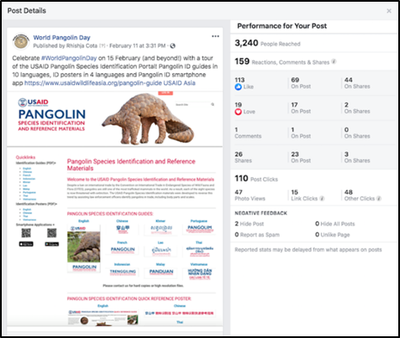Demand for Popular USAID Pangolin Species ID Guide Grows, Bolstering Counter Wildlife Trafficking Efforts
Since then, the Guide and smartphone app have been translated into ten languages (Chinese, English, French, Indonesian, Khmer, Lao, Malay, Portuguese, Thai and Vietnamese), and the posters are available in Chinese, English, Thai and Vietnamese. The pangolin species identification materials include the Pangolin Species Identification Guide, smartphone app (iOS and Android) available on Mac App Store and Google Play, and posters.
These materials have been widely distributed to law enforcement officers who work at entry ports, such as international airports, seaports, and land border crossings, especially in Asia, the world’s largest demand region for trafficked wildlife and wildlife products.
Demand for the materials and app has been surging. A link to the portal posted on the popular World Pangolin Day Facebook page in February 2020, for example, received the highest engagement of any post on the social media page – reaching 3,200 users, and getting a record number of comments, likes, and shares.
Recognizing the usefulness of the materials and with a growing interest in these tools, USAID Wildlife Asia’s partners have rallied to help disseminate, institutionalize, and sustain them.
In Thailand, the Department of National Parks, Wildlife and Plant Conservation printed 150 posters and distributed them to wildlife checkpoints throughout the country.
In Vietnam, the USAID Saving Species program, working with the CITES Management Authority, printed over 3,000 copies of the Guide and distributed them to law enforcement agencies across the country. USAID Saving Species also printed 500 posters for distribution through the Lao Cai Department of Agriculture and Rural Development (DARD) at provincial level. Vietnam Customs printed a further 800 Guide copies, and circulated them to 36 offices and checkpoints throughout Vietnam.
The materials have proven useful not just to law enforcement agencies, but to other counter wildlife trafficking stakeholders as well.
“Thanks to the Pangolin Species Identification Guide, we were able to confirm that so-called ‘farmed’ pangolins were actually wild-caught in a different range state, and thus, in violation of the law,” said a wildlife crime investigator from an international NGO (name withheld due to an ongoing case).
One big step towards institutionalization is that the suite of materials was uploaded by the CITES Parties on the CITES Virtual College website. UNEP-WCMC was also recently requested by the CITES Secretariat to make these materials more readily discoverable by CITES Parties, which will include linking USAID Wildlife Asia’s pangolin identification materials to the CITES Checklist and Species+ sites. Moreover, a growing number of organizations are adding a link to the USAID Pangolin Species Identification Portal on their websites. To date this has included IUCN, WWF, Annamiticus, and the African Pangolin Working Group.
The pangolin identification materials are now being used at major CWT training events. TRAFFIC and TRACE Wildlife Forensics, for example, utilized hard copies of the Guide in English and Malay for the 2018 South Asia and East Asia Wildlife Forensics Network Meeting.
The pangolin species identification materials will now continue to be accessible even after the completion of USAID Wildlife Asia project. The smartphone app will continue to be maintained and managed by the Tucson-based education organization Annamiticus, and will remain available for iOS and Android downloads. Annamiticus currently manages high visibility wildlife-related content, such as the World Pangolin Day and World Rhino Day website, Facebook, and Twitter accounts. USAID’s Pangolin Species Identification Guide app will become an integral part of this content, including potentially new and improved features released on subsequent World Pangolin Days. As a result, law enforcement agencies and officers working to combat illegal wildlife trade will continue to have the identification tools necessary to help protect pangolins.#
USAID Wildlife Asia’s library of pangolin materials is available via a dedicated page on the USAID Wildlife Asia website (https://www.usaidwildlifeasia.org/pangolin-guide). This portal provides all of the pangolin species identification materials in one streamlined location. With one simple click, users can access the information immediately from smartphones, tablets, laptops and desktop computers. They can download the Pangolin Species ID Guide (PDF) and the smartphone app, print the posters, and request printing information for hard copies of the Guide.


